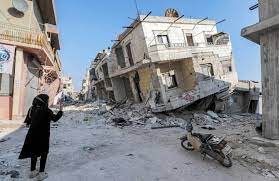BEIRUT (AFP): Two weeks after a deadly earthquake struck Syria, only a trickle of UN aid has entered the rebel-held northwest of the war-ravaged country, with the slow pace sparking outrage and anger.
The 7.8-magnitude quake killed more than 44,000 people in Turkiye and Syria, including 3,600 in Syria, piling more misery on a population who activists say has been abandoned by the world in the midst of tragedy.
More than four million people live in areas outside government control in Syria’s north and northwest, 90 percent of whom depend on aid to survive.
Yet the first UN aid convoy crossed into the area on February 9 — three days after the quake struck — and carried tents and other relief for 5,000 that had been expected before the earthquake.
The UN largely delivers relief to Syria’s northwest via neighboring Turkiye through the Bab Al-Hawa crossing — the only way for aid to enter without Damascus’ permission.
The number of UN-approved crossings has shrunk from four in 2014 after years of pressure from regime allies China and Russia at the UN Security Council.
With the road leading to Bab Al-Hawa briefly damaged after the quake and aid workers in the devastated areas also affected, international pressure mounted for relief to pour in.
On February 13, the United Nations said Damascus had allowed it to also use Bab Al-Salama and Al-Rai crossings for three months.
Turkish-backed rebels operate the two crossings in the northern Aleppo province, while the jihadist Hayat Tahrir Al-Sham (HTS) group controls Bab Al-Hawa in the Idlib region.
Despite the additional crossings, relief workers say the UN aid deliveries remain insufficient.
Since the quake struck, the UN said it sent nearly 200 trucks to northwest Syria — less than the weekly average of 145 recorded in 2022 according to Doctors Without Borders (MSF).
Syria’s White Helmets rescue group which operates in rebel-held areas have slammed the UN’s slow response, calling it a “crime.”
On February 12, UN relief chief Martin Griffiths acknowledged the body had “failed the people of northwest Syria.”
Stephane Dujarric, spokesman for UN Secretary-General Antonio Guterres, said Monday that 10 aid trucks had crossed at the Al-Rai border point.
“This is the first UN convoy through this border crossing since the Government of Syria agreed to its use for aid deliveries, which now brings us to three fully operating border crossings for the United Nations.”
International aid groups are not bound by the UN’s cross-border aid mechanism and can truck aid through other crossings with Turkiye’s approval.
International organizations also provide funding to aid groups in the northwest to “buy what they need either from the local market or from Turkiye through commercial crossings,” said Racha Nasreddine of ActionAid.
But with millions made homeless by the quake, stocks of blankets, food and tents were quickly depleted.
Although donations poured in, local groups struggled to secure necessities as prices of basic goods shot up at home while roads leading to Turkiye were damaged in the tremor, she said.
And while planeloads of foreign aid flooded regime-held areas after the quake, Syria’s northwest was largely left to fend for itself.
Although the government of Syrian President Bashar Assad does not control crossing points with Turkiye, the United Nations sought its approval to use them.
Syria and its ally Russia have long insisted that all relief pass through regime-controlled areas and Moscow has threatened to veto the UN cross-border mechanism at past security council meetings.
Many aid groups say they do not trust Syrian authorities to dispatch aid to areas under rival control.
On February 10, the Assad regime said it approved the delivery of humanitarian aid directly from government-held territory to rebel areas.
But the head of the jihadist HTS group, Abu Mohammed Al-Jolani, has said he would refuse any aid crossing going that route.
Nearly three million people, most of whom have been displaced by Syria’s war, live in the Idlib region under HTS control, while 1.1 million reside in areas of northern Aleppo held by Turkish proxies.
Turkish troops and about 30 Ankara-backed groups control border areas administered by local councils affiliated with nearby Turkish governorates.
Rival Kurdish authorities that rule swathes of the northeast sent 30 fuel tankers to northern Aleppo, but the convoy had to turn back after failing to get the greenlight to cross.







